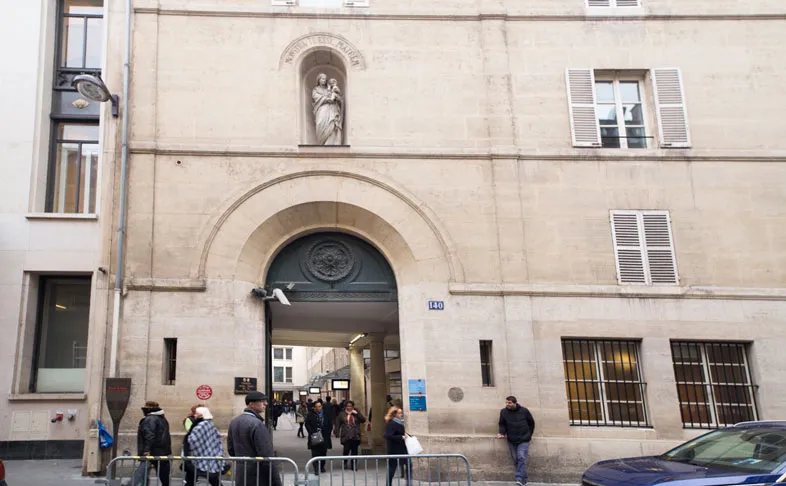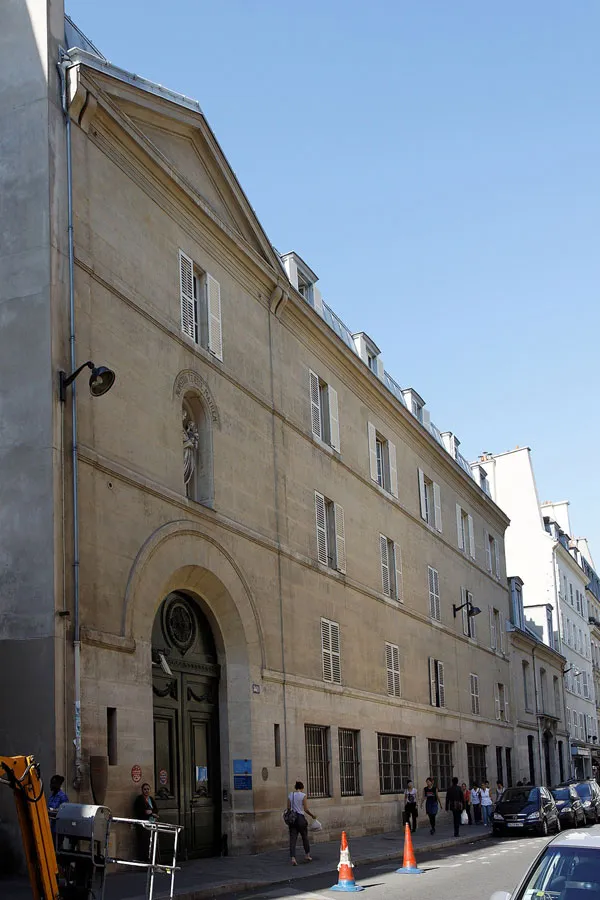
Introduction
The Chapel of Our Lady of Graces of the Miraculous Medal, or more simply “Chapel of Our Lady of the Miraculous Medal”, in 140 Rue du Bac, Paris, France, is the chapel where the Blessed Virgin Mary appeared to Catherine Labouré in 1830 and requested the creation of the medal that came to be known as the “Miraculous Medal”. The chapel was part of the mother house of the religious congregation of the Daughters of Charity of Saint Vincent de Paul. Catherine Labouré was a seminary sister (novice) there when she witnessed the Marian apparitions.
The chapel of Our Lady of Graces of the Miraculous Medal, Paris is more commonly referred to by its address, “140 rue du Bac”, or even simply the street on which it is located, Rue du Bac, Paris.
The Chapel of Our Lady of the Miraculous Medal is an important place of prayer and pilgrimage that draws believers from all over the world ho wish to prayerfully reflect and ask the Virgin Mary’s protection.
The Miraculous Medal (French: Médaille miraculeuse), also known as the Medal of Our Lady of Graces, is a devotional medal, the design of which was originated by Saint Catherine Labouré following her apparitions of the Blessed Virgin Mary in Rue du Bac, Paris, France. It was made by goldsmith Adrien Vachette.
According to the teaching of the Catholic Church, the use of sacramentals such as this medal prepares people to receive grace and disposes them to cooperate with it.
Our Lady of Graces (Italian: Madonna delle Grazie or Nostra Signora delle Grazie) or Saint Mary of Graces (Italian: Santa Maria delle Grazie) is a devotion to the Virgin Mary in the Roman Catholic Church. Several churches with this dedication often owe their foundation to thankfulness for graces received from the Virgin Mary, and are particularly numerous in Italy, India, Australia, United States, Portugal, France and the Italian-speaking region of Switzerland. Also it is related to the Marian apparitions in which was revealed the Miraculous Medal, also known as the Medal of Our Lady of Graces.
History of Our Lady of Graces of the Miraculous Medal, Paris
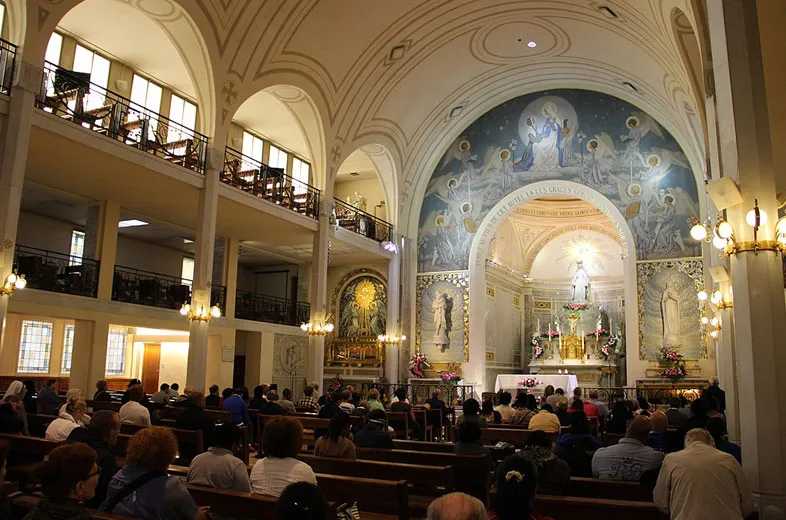
Our Lady of Graces of the Miraculous Medal, Paris – In 1813 the construction of a chapel began in the Hôtel de Châtillon. On August 6, 1815 the solemn benediction of the chapel was dedicated to the Sacred Heart of Jesus.
Pope Leo XIII granted the venerated Marian image a decree of pontifical coronation on 2 March 1897 via the Archbishop of Paris, Cardinal François-Marie-Benjamin Richard. The image was then crowned on 26 July 1897.
Catherine Labouré stated that on 18 July 1830, the eve of the feast of Saint Vincent de Paul, she woke up after hearing the voice of a child calling her to the chapel, where she heard the Virgin Mary say to her, “God wishes to charge you with a mission. You will be contradicted, but do not fear; you will have the grace to do what is necessary. Tell your spiritual director all that passes within you. Times are evil in France and in the world.”
On 27 November 1830 Catherine reported that the Blessed Mother returned during evening meditations. She displayed herself inside an oval frame, standing upon a globe. She wore many rings set with gems that shone rays of light over the globe. Around the margin of the frame appeared the words Ô Marie, conçue sans péché, priez pour nous qui avons recours à vous (“O Mary, conceived without sin, pray for us who have recourse to thee”).
As Catherine watched, the frame seemed to rotate, showing a circle of twelve stars, a large letter M surmounted by a cross, and the stylized Sacred Heart of Jesus crowned with thorns and Immaculate Heart of Mary pierced with a sword. Asked why some of the gems did not shed light, Mary reportedly replied, “Those are the graces for which people forget to ask.” Sister Catherine then heard the Virgin Mary ask her to take these images to her father confessor, telling him that they should be put on medallions, and saying “All who wear them will receive great graces.
Sister Catherine did so, and after two years of investigation and observation of Catherine’s ordinary daily behavior, the priest took the information to his archbishop without revealing Catherine’s identity. The request was approved and medallions were designed and produced through goldsmith Adrien Vachette.
Our Lady of Graces of the Miraculous Medal, Paris in which Saint Catherine experienced her visions is located at the mother house of the Daughters of Charity in Rue du Bac, Paris. The incorrupt bodies of Saint Catherine Labouré and Saint Louise de Marillac, a co-founder of the Congregation of the Daughters of Charity of Saint Vincent de Paul, are interred in the chapel, which continues to receive daily visits from Catholic pilgrims today.
Pope John Paul II used a slight variation of the reverse image as his coat of arms, the Marian Cross, a plain cross with an M underneath the right-hand bar (which signified the Blessed Virgin at the foot of the Cross when Jesus was being crucified).
Apparitions

The chapel at Rue du Bac (Our Lady of Graces of the Miraculous Medal, Paris), is the site of a number of apparitions said to have been experienced by Labouré. It was here on three successive days, while praying, that Vincent de Paul showed her his heart, each time in a different colour. His heart appeared white, the colour of peace; then red, the colour of fire; and then black, an indication of the misfortunes that would befall France and Paris specifically.
Shortly after, Labouré saw Christ present in the Sacred Host, and on 6 June 1830, the Feast of the Holy Trinity, Christ appeared as a crucified king, stripped of all his adornments.
In 1830 Labouré, then 24 years old, received three visits from the Blessed Virgin Mary. On the first visit, the night of 18 July, she received a request that a Confraternity of the Children of Mary be established. Later Mary requested the creation of a medal with the following invocation: “O Mary, conceived without sin, pray for us who have recourse to thee.” From May 1832 onwards the medal, which was extraordinarily disseminated and is said to convert, protect, and perform miracles, was called “miraculous” by the faithful.
In 1849 the chapel was expanded and thereafter other modifications were executed. Since 1930, the date of its complete renovation, the chapel is as it is known today.
Pilgrimage
The chapel of Our Lady of Graces of the Miraculous Medal, Paris, as a site of Marian apparition, is a Marian shrine and hence a site of Catholic pilgrimage.
The wax effigy containing the bones of Louise de Marillac and the heart of Vincent de Paul, founders of the Daughters of Charity of Saint Vincent de Paul, are kept there. The incorrupt body of Catherine Labouré, member of the Daughters of Charity of Saint Vincent de Paul and famous Marian visionary, also lies in a glass coffin at the side altar of the chapel.
The Apparitions and the Miraculous Medal
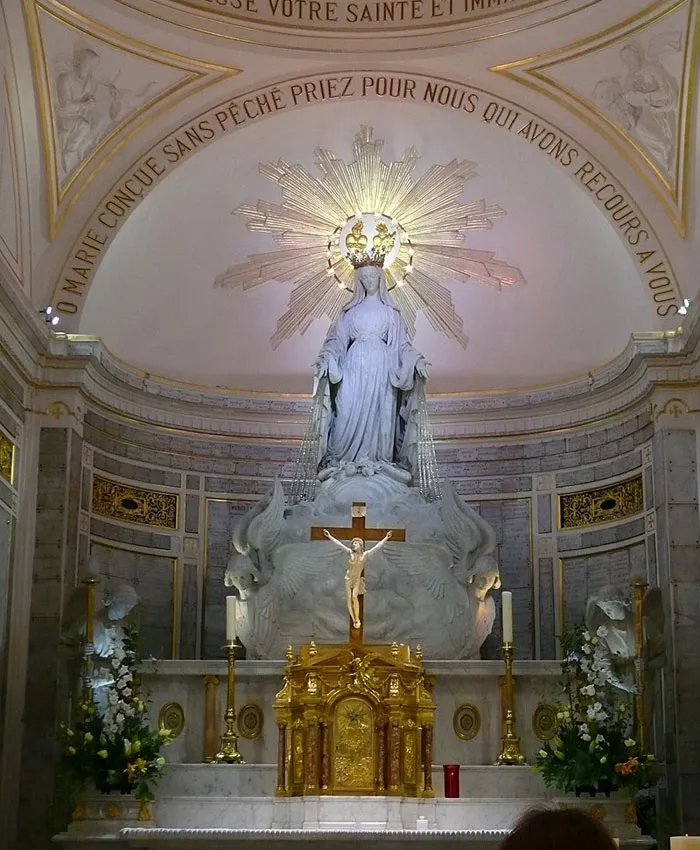
The chapel of Our Lady of Graces of the Miraculous Medal, Paris was built in 1815 and was dedicated to the Sacred Heart of Jesus. In 1830 it was privileged with the extraordinary events of the apparitions of the Blessed Virgin to Sister Catherine Labouré that marked it forever.
The Appearances
Heaven came down to earth… Between July and December 1830 Sister Catherine, a young Seminary Sister (novice) of the Daughters of Charity, received the extraordinary favor of conversing with the Virgin Mary on three occasions. In the preceding months Catherine had the privilege of other apparitions. Saint Vincent de Paul showed her his heart. While at prayer in the chapel, Catherine saw, on three successive days, the heart of Saint Vincent in three different colors.
The heart first appeared white, the color of peace; then red, the color of fire; and then black, an indication of the misfortunes that would come upon France and Paris in particular. Soon afterwards, Catherine saw Christ present in the Eucharistic host. “I saw Our Lord in the Blessed Sacrament all the time of my seminary except the times when I doubted.” On June 6, 1830, feast of the Holy Trinity, Christ appeared as a crucified King, stripped of all his adornments.
July 18, 1830
July 18, 1830, the eve of the feast of Saint Vincent whom she loved so much and whose heart she had seen overflowing with love, Catherine prayed that, through his intercession, her desire to see the Blessed Virgin would finally be fulfilled. At eleven-thirty at night, she was called by name. A mysterious child was at the foot of her bed and asked her to get up. “The Blessed Virgin is waiting for you.” Catherine dressed and followed the child who was “bringing rays of brightness wherever he passed.”
Having arrived in the chapel, St. Catherine stopped near the chair used by the priest in the sanctuary (current location of the statue of Saint Joseph). She then heard a sound “like the rustle of a silk dress.” Her little guide said, “Here is the Blessed Virgin.” She hesitated. But the child repeated in a stronger tone of voice, “Here is the Blessed Virgin.” In a single bound, Catherine was at the feet of the Blessed Virgin, seated on a chair and rested her hands on the knees of the Mother of God.
“There, a period of time passed, the sweetest of my life. It would be impossible for me to say what I experienced. The Blessed Virgin told me how I should behave towards my spiritual director and also several other things.” The Blessed Virgin pointed to the altar where the tabernacle was and said, “Come to the foot of this altar. Here, graces will be spread over all who ask for them with confidence and fervor.”A difficult mission was announced as well as a request for the establishment of a Confraternity of the Children of Mary. Father Aladel would accomplish this request on February 2, 1840.
November 27, 1830
On November 27, 1830, the Blessed Virgin appeared to Catherine again in the chapel. This time, it was at 5:30 pm, during meditation, under the painting of Saint Joseph (current location of Our Lady of the Globe). First, Catherine saw something like two living paintings, one fading into the other, in which the Blessed Virgin stood on a half-globe, her feet crushing a serpent. In this first image, the Virgin held a small golden globe topped with a cross, which she lifted up toward heaven. Catherine heard, “This globe represents the entire world, including France, and every person.”
In the second image, beautiful rays of light stream from the Blessed Virgin’s open hands, covered with jeweled rings. At that same moment St. Catherine heard a voice saying, “These rays are a symbol of the graces that I pour out on those who ask them of me.” Then an oval formed around the apparition, and Catherine saw in a semi-circle this invocation: “O Mary conceived without sin, pray for us who have recourse to you,” emblazoned in gold letters. She then heard a voice saying, “Have a medal made according to this model.
For those who wear it with confidence, there will be abundant graces.” Finally, the image turned, and Catherine saw the reverse side of the medal: the letter M surmounted with a little cross and two hearts, one crowned with thorns and the other pierced with a sword, below.
December 1830
In the month of December 1830, during meditation, Catherine again heard the rustling sound, this time behind the altar. The same image of the medal appeared near the tabernacle, slightly behind it. “These rays are the symbol of the graces that the Blessed Virgin obtains for those who ask them of her…You will not see me anymore .” This was the end of the appearances. Catherine communicated the requests of the Blessed Virgin to Father Aladel, her confessor. He was not receptive to her message and forbade her to even think about it. This was a terrible blow for her.
On January 30, 1831, Catherine finished her Seminary and received the habit of the Daughters of Charity. The next day, she set off for the Hospice of Enghien, which had been established by the Orléans family and was located at 12 rue de Picpus on the east side of Paris, in an impoverished neighborhood where she served elderly men and poor persons for 46 years quietly and in complete obscurity.
The Miraculous Medal

In this chapel Our Lady of Graces of the Miraculous Medal, Paris, chosen by God, the Virgin Mary came in person to reveal her identity through a little object, a medal, intended for all without distinction. Mary’s identity had been the subject of controversy among theologians since the beginnings of the Church. In 431 the Council of Ephesus proclaimed the first Marian dogma: Mary is the Mother of God.
Starting in 1830, the invocation, “O Mary conceived without sin, pray for us who have recourse to you,” which rose up toward heaven, repeated thousands of times in the hearts of thousands of Christians all over the world at the request of that same Mother of God, would have an effect! On December 8, 1854, Pius IX proclaimed the dogma of the Immaculate Conception: by a singular privilege and grace granted by God, in view of the merits of Jesus Christ, the Savior of the human race, Mary is without sin from the moment of her conception.
Four years later in 1858, the apparitions at Lourdes would confirm to Bernadette Soubirous this privilege of the Mother of God. With her immaculate heart, Mary is the first redeemed by the merits of Jesus Christ. She is light for our world. We are all, like her, destined for eternal happiness. Some months after the apparitions, Sister Catherine was assigned to the Hospice of Enghein (in the 12th district of Paris) to care for elderly men. She set about her work; however, an interior voice kept insisting that the Medal must be struck. Catherine spoke about it again to her confessor, Father Aladel.
In February 1832 a terrible cholera epidemic broke out in Paris and would cause more than 20,000 deaths. In June the Daughters of Charity began to distribute the first 2000 medals produced at Father Aladel’s request. Cures accumulated, as did protection from the disease and conversions. It was overwhelming. The people of Paris began to call the medal “miraculous”.
By autumn of 1834 there were already 500,000 medals in existence. In 1835 there were more than one million worldwide, and in 1839 more than 10,000,000 medals had been distributed. At the time of the death of Sister Catherine, in 1876, there were more than a billion medals. The words and images on the front of the medal express a message with three tightly connected aspects.
“O Mary conceived without sin, pray for us who have recourse to you.” Mary’s identity is explicitly revealed to us here:the Virgin Mary is immaculate from the moment of her conception. The power behind her intercession for those who pray to her comes from this privilege derived from the merits of the Passion of her Son Jesus Christ. This is why the Virgin invites everyone to have recourse to her in the difficulties of life.
Her feet are planted on a half-sphere and crush the head of a serpent. This half-sphere is the globe. For Jews and Christians, the serpent personifies Satan and the forces of evil. The Virgin Mary is herself engaged in a spiritual battle, the battle against evil, and the battlefield is our world. She calls us to enter with her into God’s way of thinking, which is not the way of the world. This is the true grace of conversion that Christians should ask of Mary so that they can in turn pass it on to the world.
Her hands are open and her fingers are adorned with rings, decorated with precious stones. These jewels emit rays of light, becoming increasingly bigger as they beam toward earth. The radiance of these beams, like the beauty of the apparition described by Catherine, calls forth, justifies and strengthens our trust in Mary’s faithfulness (the rings) towards her Creator and towards her children, in the efficacy of her intervention (the rays of grace that fall on the earth), and in the final victory (the light), since she, as the first disciple, is the first saved.
On the back of the medal, a letter and drawings introduce us to the secret of Mary. The letter “M” is surmounted by a cross. The “M” is Mary’s initial; the cross is the Cross of Christ. The two interwoven signs show the inseparable relationship that connects Christ to his Holy Mother. Mary is associated with the mission of human salvation through her Son Jesus and, through her compassion, participates in the very act of the redeeming sacrifice of Christ. There are two hearts at the bottom, one encircled by the crown of thorns and the other pierced by a sword.
The heart crowned with thorns is the Sacred Heart of Jesus. It recalls the cruel episode of Christ’s Passion before He was put to death, as recounted in the Gospels. It represents His passionate love for humanity. The heart pierced by a sword is the Immaculate Heart of Mary, his Mother. It recalls Simeon’s prophecy the day Mary and Joseph presented Jesus in the temple, as recounted in the Gospel. It represents the love of Christ that dwells within Mary and her love for us: for the sake of our Salvation she accepted the sacrifice of her own Son. Depicting these two hearts close together indicates that Mary’s life is one of intimacy with Jesus.
Twelve stars are engraved around the medal’s edge. They represent the twelve apostles and thus the Church. To belong to the Church is to love Christ and to participate in his passion for the salvation of the world. Each baptized person is invited to become a part of the mission of Christ by uniting his heart to the hearts of Jesus and Mary.
The medal appeals to our conscience so that each one of us might thing, as did Christ and Mary, the path of love even unto the total gift of self.
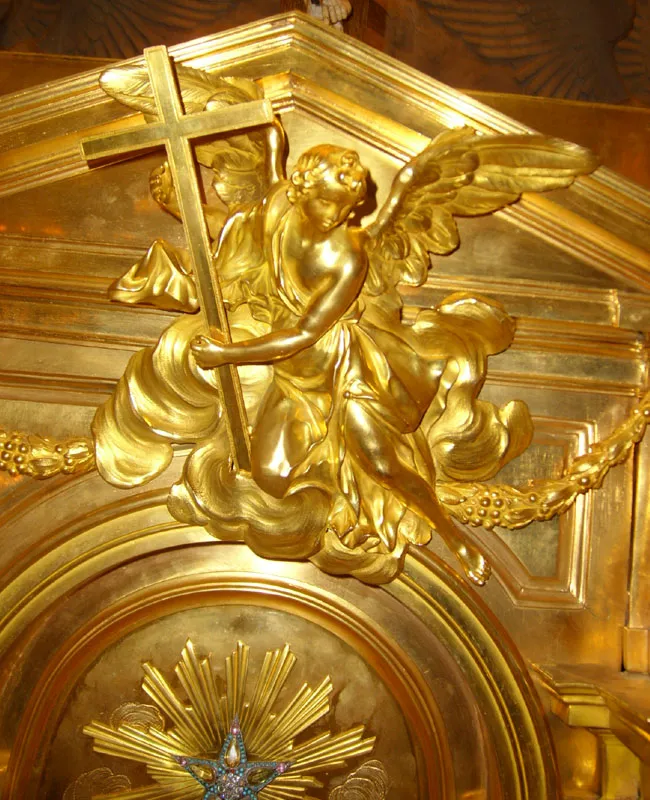
Properties of the Medal
Front side:
- Mary stands on the earth, crushing a serpent beneath her feet. Describing the original vision, Catherine said the Blessed Mother appeared radiant as a sunrise, “in all her perfect beauty.”
- Rays shine forth from Mary’s hands. She told Catherine these “symbolize the graces I shed upon those who ask for them.”
- Words from the vision, originally in French, form an oval frame around the image: “O Mary, conceived without sin, pray for us who have recourse to thee.”
Reverse side:
- A cross-and-bar surmount a large, bold “M”.
- Twelve stars mark the perimeter.
- Two hearts are depicted underneath the “M”, the left lapped with a crown of thorns, the right skewed by a sword. From each, a flame emanates from the top.
Our Lady of Grace
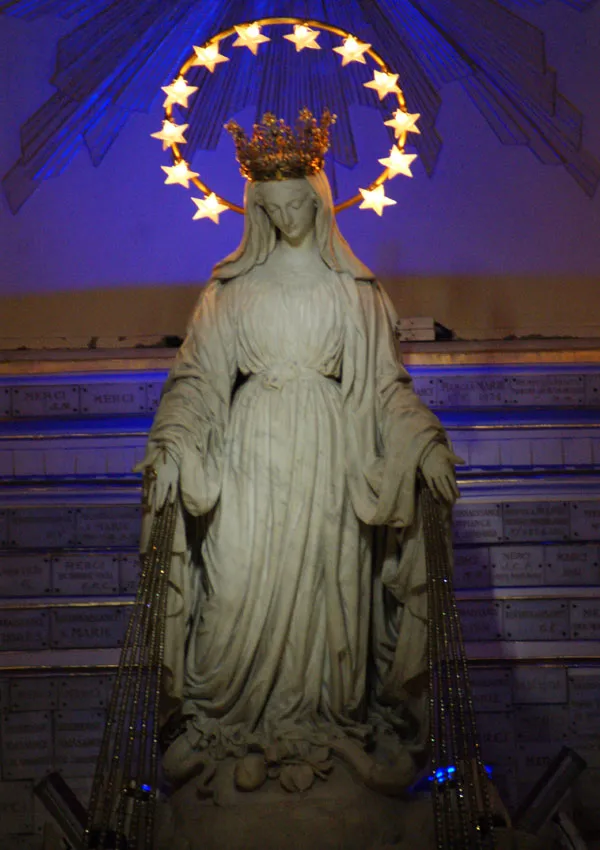
The Chapel of Our Lady of Graces of the Miraculous Medal, Paris – Our Lady of Grace is a Title of Mary. The feast day associated with this title is February 7. The title of Our Lady of Grace is venerated in many countries throughout the world under various aspects. Many parishes, churches, and schools bear this name.
A major shrine in pre-Reformation England was that of “Our Lady of Grace” at Ipswich, also known as “Our Lady of Ipswich”. Its first recorded mention is in 1152. In 1297, the marriage of Elizabeth of Rhuddlan, youngest daughter of King Edward I and Eleanor of Castile took place at the Shrine of Our Lady of Grace. During the Middle Ages the Marian Shrine of Our Lady of Grace was a famous pilgrimage destination, and attracted many pilgrims including Henry VIII and Katherine of Aragon.
Only Walsingham attracted more pilgrims. At the Reformation the statue was taken away to London to be burned in 1538, though some claim that it survived and is preserved at Nettuno, Italy. Whether it was brought there by Catholic sailors, according to local legend, or simply sold by associates of Thomas Cromwell, the Nettuno statue appears to bear an English provenance.
History of Our Lady of Grace
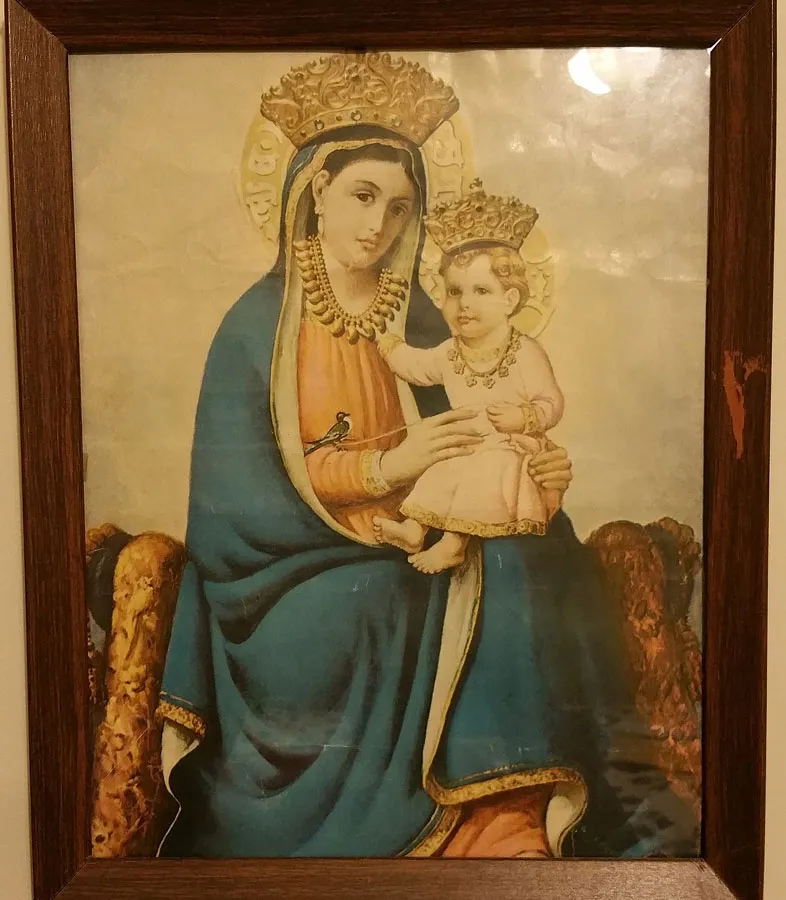
The polychromed wooden statue of Our Lady of Grace is carried in procession every year in Nettuno on the first Saturday of May. The Anglican Church of St Mary at the Elms in Ipswich houses a copy of the Nettuno statue. Every year parishioners from St. Mary’s and the Roman Catholic Church of St. Pancras join in a pilgrimage to the former site of the Shrine, which was just outside the city’s west gate.
According to Rev. Johann Roten S.M., The title is French in origin, “Notre Dame de Grâce” and refers to an icon venerated in Cambrai. It was acquired by Cardinal Jean Allarmet, who gave it to his secretary Fursy de Bruille, a canon of the Cambrai cathedral chapter, in Rome in 1440. De Bruille brought it to Cambrai, and in 1450 presented it to the Old Cambrai Cathedral, where it was installed with great ceremony in the Chapel of the Holy Trinity.
It was believed an original by Saint Luke, patron saint of artists, for which Mary herself had sat as model. Thus it was treated as a relic; God bestowing blessings on those that travelled to view it. It is carried in an annual procession through the streets of Cambrai on the day before the Assumption (August 15).
Another depiction of Our Lady of Grace is located at the Döbling Carmelite Nunnery in Vienna, where it is also known as “Our Lady of the Bowed Head”. An oil painting of the 15th or 16th century, according to legend, it was discovered by a Carmelite friar in a rubbish heap in the Trastevere and miraculously spoke to him while he was attempting to clean it. Restored, it eventually was brought to the court in Munich. Ferdinand II, Holy Roman Emperor attributed his 1620 victory at the Battle of White Mountain to Mary’s help.
One image associated with “Our Lady of Grace” is that displayed on the Miraculous Medal. Catherine Labouré, a French member of the Daughters of Charity of Saint Vincent de Paul, reported that in 1830, she experienced a vision of Mary in the convent chapel on the Rue du Bac, in Paris.
Labouré said that Mary appeared standing upon a globe with her arms outstretched. As if from rings set with precious stones, dazzling rays of light were emitted from her fingers. When asked why all the rings did not emit light, the apparition responded that these were graces for which people forget to ask. The front of the medal depicts this image.
The High Altar
The Chapel of Our Lady of Graces of the Miraculous Medal, Paris – On February 7, 1850, the Minister of the Interior said he granted various blocks of marble for the construction of two altars in the Chapel. One of the marble blocks was used to build the current high altar. This one is majestic, enhanced with gilded carvings and encrusted with medallions containing relics. The tabernacle, massive, also comes from the rue du Vieux Colombier, where it was in the chapel of the Sisters of Mercy, well before the Revolution, which allows us to date its origin from the 17th or 18th century.
These nuns were happy later to learn that their beautiful tabernacle was in the possession of the Daughters of Charity. It looks a bit like a Greek temple, with its pediment decorated with an angel carrying a cross. On the finely carved door is represented a nativity, surmounted by a shining star. The perimeter of what constitutes the dome is decorated with basins, while marble columns surround the door. On each side of the altar, we can see two light-bearing angels and, on the tabernacle, a very beautiful ivory crucifix, remarkably worked.
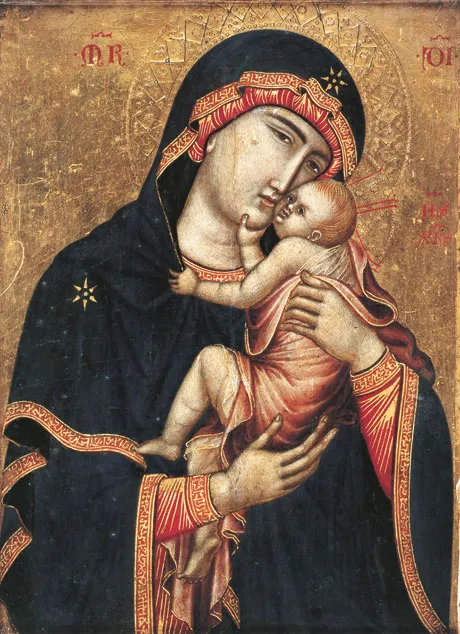
The Statue of the Virgin of the Rays
A Temporary Plaster Statue had been placed on the High Altar. Today, it is the marble statue that dominates the entire Chapel, carved from the block of marble offered to the Community by the Government. The pose of the statue was done solemnly in 1856. In 1914, two seraphim were placed below, surrounded by a cloud which they supported by their shoulders.
Virgin on the Globe
The Chapel of Our Lady of Graces of the Miraculous Medal, Paris – The Virgin holds the world in her hands and offers it to Divine Mercy. Sister Catherine, at the request of the Virgin, strongly insisted that a statue be made representing the Virgin holding a globe in her hands, and designated the place where she should be placed (Apparition above the painting St Joseph).
In 1841, Mr. Aladel tried, without success, to obtain the agreement of Rome to erect this representation. In 1876, Sr Dufès resumed the project according to the indications received: “The Virgin had a dress and a white veil falling to the feet, a headband trimmed with lace, the feet on a half globe and under the feet a snake greenish with yellow spots, but above all, she held in her hands a golden globe surmounted by a small cross which she offers”.
Sr Dufès asked the Froc-Robert workshops to make it. But Sister Catherine was not satisfied with the work of the sculptor. With the permission of the Superiors, Sister Dufès placed this statue in her study in Reuilly. It was only after the death of Sister Catherine, in 1880, that Monsieur Fiat, Superior General, had a statue made to be placed in the Chapel, on an altar established at the place where Catherine had requested it… This statue remained in the chapel until 1930. Too small in size, it was replaced by a Carrara marble statue executed by Real Del Sarte.

The Crown
The Chapel of Our Lady of Graces of the Miraculous Medal, Paris – On February 11, 1896, Father Fiat, Superior General of the Congregation of the Mission and of the Daughters of Charity, sent a petition to Pope Leo XIII asking for authorization to crown the statue of the Immaculate Virgin. On March 2, 1897, the Pope addressed a Brief to Cardinal Richard, Archbishop of Paris: “Nothing is more pleasing to us”, remarked the Pope, “than to glorify, by new honors, the Immaculate Virgin, Mother of God. Cardinal Richard gladly accepted the mission entrusted to him by the Holy Father and the solemnity was fixed for July 26, 1897.
The Crown Consists of Three Elements
- The headband expresses the human kingdom and its relationship with the Blessed Virgin; the flowers symbolize the Marian virtues; nine small medallions represent the Apparitions to Saint Catherine, the Medal, Saint Vincent and Saint Louise, the conversion of Alphonse Ratisbonne, the seal of the Company.
- The stars represent the nine choirs of angels.
- The lilies at the top of the crown represent the Virgin. The screw fixing the crown on the head of the Virgin represents the arms of Pope Leo XIII in order to show that it was Jesus Christ who, himself, wanted to place this diadem on the forehead of his beloved Mother.
Altar and Statue of Saint Vincent
The Chapel of Our Lady of Graces of the Miraculous Medal, Paris – The altar which came in 1815 from the rue du Vieux Colombier served as the High Altar until 1856 when, during the work to enlarge the Chapel, it seemed too small. “Altar of the Apparitions”, it was preserved and placed in the aisle of the Chapel on the right. This aisle was dedicated to St Vincent. On April 27, 1930, Cardinal Verdier came to bless the statue of St Vincent made by Maison Raff.
In 1934, above the altar of Saint Vincent, Sister Desjeux had a mosaic made by Maison Maurméjean with this inscription on a bronze ribbon: “It is at the foot of this altar, then the main altar of the Chapel , that the 1830 Apparitions to Blessed Catherine Labouré took place. On February 15, 1947, Mother Blanchot placed the relic of the heart of St Vincent on the altar. The relic left for Turin during the Revolution.
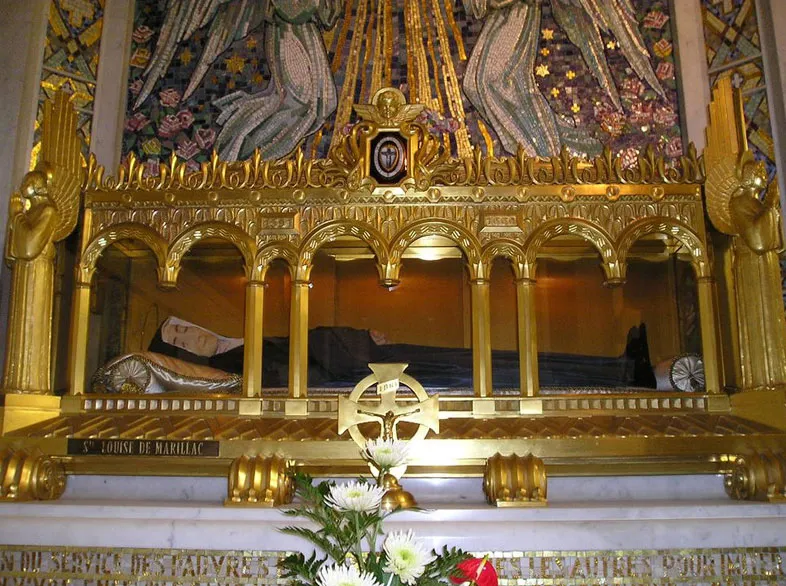
Relics of Saint Louise
As soon as Sainte Louise died, M. de Lestocq, parish priest of St Laurent, begged M. Vincent to allow him to bury his parishioner inside his church. Mr. Vincent is bedridden but agrees. The burial takes place on March 17, 1660. In 1676, Mr. Gobillon, new parish priest of St Laurent, wrote: “there comes a sweet smell of violets and irises” when we go to pray near the Chapelle de la Visitation (today the chapel of Saint François de Sales.)
On April 10, 1680, the body was exhumed. The remains of Sainte Louise are transferred to the Mother House, rue du Faubourg St Denis, Paroisse St Laurent. They remained there despite the Revolution and the departure of the Sisters.
In 1801 the government ceded to the Community the former Establishment of the Orphans of the Mother of God, rue du Vieux Colombier. The remains of Sainte Louise will not be transferred there until 1809. On July 20, 1815, they will be transferred again, without solemnity, from rue du Vieux Colombier to rue du Bac. In the central aisle of the Chapel, there is a plaque with the inscription
“Here, rested the precious body of Blessed Louise de Marillac, Co-founder of the Company of the Daughters of Charity (1824-1920)”
The relics of Saint Louise are since 1920 on one of the side altars, on the right, in a shrine.
Altar of Saint Catherine
In 1880, on the occasion of the Fiftieth Anniversary of the Apparitions, an altar was erected and placed on the very spot where the Virgin had appeared, in gratitude for her innumerable benefits. The Religious Week of the time describes the beauty of this altar: the front of the altar is in magnificent onyx cut with small lapis lazuli columns, set in gilded bronze . In the middle panel, an oval circle recalls the reverse of the Medal. In the right and left panels , gilt bronze lilies st. catherine relish
In 1933 Sister Catherine returned to the House. Like all Saints, for lack of space, she cannot rest “on” the altar. It will therefore rest “under” this altar, but here again, the space is cramped and adjustments had to be made…
Of the four pilasters, two were made to frame the reliquary. The massive part of marble on which the reverse of the Medal stood was moved back to form the bottom of the shrine. The short altar table has been replaced. Using a photo of the Servant of God, the artist who modeled the wax mask managed to give the face as perfect a likeness as possible.
The Armchair
When Saint Catherine died, the chair occupied by the Director in 1830 had not been in the Chapel for 25 years. It had been removed and placed in the sacristy to make room for stalls. It was not until 1880, on the occasion of the 50th anniversary of the Apparition that the armchair was brought back to the Chapel. It seems certain that it was on this armchair that the Blessed Virgin sat.
In addition, Sr. Dufès wrote to Fr. Fiat in 1876: “You ask me what Sr. Catherine communicated to me about the seat occupied by the Blessed Virgin, at the time of the Apparition, at midnight, in the Chapel. These are the words she used in telling me the vision: “I saw a great Lady coming down from the Tribune; she came and prostrated herself before the tabernacle and sat down in the chair of the Father Director.”
The Organ
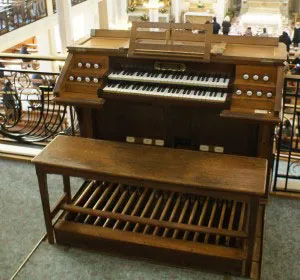
The Chapel of Our Lady of Graces of the Miraculous Medal, Paris – The Repairs to the Chapel in 1849 had greatly reduced the gallery for the Elderly Sisters where the organ was located and there was hardly any room left for them. In order not to deprive them of the view of the Chapel, an attempt was made to install the organ elsewhere and no more suitable place was found than behind the high altar, believing that it would not spoil the sanctuary and that, even, he would do ornament.
But he was no sooner placed there than it was recognized that it was a real embarrassment. Every effort was made to conceal it. Then came the idea of placing above the altar a statue of the Blessed Virgin. In 1891, the “Bell” gallery was modified to install the organ there and thus remove it from the choir. Two estimates dated October 9, 1873 bear the mark “Aristide Cavaillé-Coll” of the Manufacture d’orgues d’église.
Feast Day - 7th February
The Annual Feast Day of Our Lady of Grace is held of 7th February.
Mass Time
- Mondays : 8:30 am, 10:30 am
- Tuesdays : 8:00 am, 10:30 am
- Wednesdays : 8:00 am, 10:30 am, 12:30 pm
- Thursdays : 8:00 am, 10:30 am, 12:30 pm
- Fridays : 8:00 am, 10:00 am, 11:30 am
- Saturdays : 8:00 am, 10:30 am, 12:30 pm, 5:15 pm
- Sundays : 8:00 am, 10:00 am, 11:30 am
Church Visiting Time
- Every Days : 7:45 am to 1:00 pm & 2:30 pm to 7:00 pm
Contact Info
140 rue du Bac, 75340,
Paris Cedex 07, Paris, France
Phone No.
Tel : +33 1 49 54 78 88
Accomodations
How to reach the Chapel
Paris Charles de Gaulle Airport or Roissy Airport in Paris, France is the nearby Airport to the Chapel.
Rue du Bac Subway Station in Rue du Bac, Paris, France is the nearby Train Station to the Chapel.

